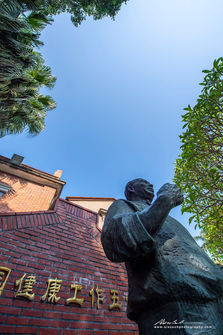
鼓浪屿 GULANGYU UNESCO NATIONAL PARK






Lu Zhuangzhang establishing the Pinyin system, promoting Mandarin and the spoken Fujian dialect.
卢戆章(1854-1928),字雪樵,厦门同安人。在鼓浪屿首创切音新字,被誉为“现代汉语拼音之父”,毕生从事拼音文字工作,不仅在创制拼音方案方面,也在推广京音官话、推行白话口语,使用简体汉字,实行汉字横排等方面,贡献卓著,是中国语言现代化运动的先驱。
Lu Zhuangzhang, known by his courtesy name Xuegiao, was a Tong' an native in Amoy. He was known as the father of the modern Chinese alphabetic system. His life work was spent on the Chinese alphabet and letters, contributing profoundly to establishing the Pinyin system, promoting Mandarin and the spoken Fujian dialect. He also introduced simplified Chinese and the horizontal layout of Chinese texts.
He was a pioneer in the modernization of Chinese.
Since the arrival of Christianity in China, the Bible has been translated into many varieties of the Chinese language, both in fragments and in its totality. The first translations may have been undertaken as early as the 7th century AD, but the first printed translations appeared only in the nineteenth century. Progress on a modern translation was encumbered by denominational rivalries, theological clashes, linguistic disputes, and practical challenges at least until the publication of the Protestant Chinese Union Version in 1919, which became the basis of standard versions in use today.
Although the motive for making translations was to spread the Gospel, there were further consequences. Access to the Bible in their own language made it easier for Chinese to develop forms of Christianity not dependent on missionaries and foreign churches. Translations designed to be read aloud were significant not only for Christian believers, but for Chinese who wanted models for writing in the vernacular. Since regional languages or dialects could not be adequately written using Chinese characters, phonetic systems and type faces had to be invented; Christian texts were often the first works to be printed in those languages. The task of translation motivated missionaries to study Chinese closely, contributing to the development of Sinology. The Bible, especially the Old Testament, also offered Chinese revolutionaries such as the leaders of the nineteenth-century Taiping Rebellion an apocalyptic vision of social justice on which to base their claims.
Hanyu pinyin, the phonetic symbols for Chinese characters, is the system to transcribe Mandarin Chinese sounds into a Latin alphabet. It was invented in 1950s, and adopted officially in mainland China in 1958. Pinyin is used for several purposes. It can help learners of Chinese (including native speakers) to read Chinese characters and/or words. It can be used to transcribe names and places into words accessible to Romanized language speakers, and it can be used as an input method for typing Chinese characters.




























